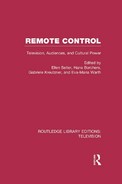Preface
It is perhaps symbolic of the pervasiveness of television in our world today that the symposium “Rethinking the Audience: New Tendencies in Television Research,” which gave rise to the present volume and the essays it contains, should have taken place at the University of Tubingen's Heinrich-Fabri-Institute in Blaubeuren. Blaubeuren is a small German town hidden away among the hills of the Swabian Alp; Heinrich Fabri belongs to the town's medieval history. One of the founding fathers of the nearby university, he served as abbot to Blau-beuren's Benedictine monastery back in the fifteenth century. Where in Fabri's day scholar-monks had pored over their palimpsests, a group of some forty twentieth-century scholars from all over the world met from February 17 to 20, 1987, to consider what is arguably the most influential palimpsest of our present-day cultural situation – television; their specific goal on this occasion was to discuss television audiences.
The impulse for this gathering originated within a research project on the soap opera as a prominent phenomenon in twentieth-century American culture. The project was planned and undertaken by the University of Tubingen's Department of American Studies in 1985 and funded by the West German Volkswagen Foundation. Although soap operas have for some time been a privileged object of Anglo-American television research, scholarly interest has begun to grow in other countries in direct proportion to the genre's growing global appeal. As the four principal researchers of the project, we soon felt the necessity of involving the project and ourselves in the very lively scholarly debate on television audiences. It was in connection with an ethnographic study we did with American soap opera viewers in the summer of 1986 (see our essay in this volume, pp.223–47) that we decided to organize the symposium.
Motivation to provide a platform for an exchange of opinions about today's trends in television audience research did not come from the project alone, but also from our perception of similar trends in the field of American Studies. To put it in very general terms, the discipline has moved over the past fifteen years from a preoccupation with the artist as the shaper of cultural identity to a growing concern for the social structures undergirding artistic and intellectual creation as well as for the varieties of subcultural expression. At the heart of this new American Studies paradigm are two important elements. One is the central question of how groups of people generate and reproduce cultural meaning. The other is the ongoing debate over the various methodologies that help us address this question. Janice Radway's 1984 investigation of American women who are habitual readers of romances comes to mind as representative of the new tendencies in American Studies and of their affinity to the current concerns with the readers of television texts.1
More than other publications, a collection of essays deriving from a symposium is the product of a collaborative effort. As organizers of the symposium and editors of the ensuing anthology we are very grateful to all who helped us achieve our goals. First and foremost, our acknowledgments are due to the participants of the symposium. Their contributions, both as readers of papers and as speakers during the discussion periods, have made this volume possible. Lack of space unfortunately does not permit us to cite their individual names.
If we make an exception, it is because of a feeling of special indebtedness. Herta Herzog has taken an active interest in the above-mentioned soap opera project since its inception, sharing with us her extensive scholarly experience and her keen insights. While we are very appreciative of her participation in the project, we would also like to express our gratitude for her pioneering research in the field of audience studies – research that goes back as far as the 1930s and that has inspired a whole subsequent generation of scholars.
Special thanks go to those symposium participants whose contributions appear in the present volume. We appreciate their willingness to thoroughly revise their papers and their patience with our sometimes demanding editorial requests.
We would also like to acknowledge our indebtedness to the institutions which made the symposium and, by extension, this volume possible. We are grateful to the Volkswagen Foundation for awarding us a second grant, thereby enabling us to bring together in Blaubeuren a unique group of television scholars, several of whom came from as far away as Australia, Israel, and the United States. Our sincere thanks also go to the University of Tübingen and to the Department of American Studies for providing the logistics indispensable for the organization of an international conference, and to Ute Bechdolf and Margarete Endress for their efficient assistance with all the nitty-gritty details of organizing a symposium and preparing a manuscript.
Finally, we would like to express our gratitude to Jane Armstrong of Routledge for her unfailing support and to Rosamund Howe for her editorial guidance.
Hans Borchers
Tübingen, March 1989
Note
1 Janice Radway, Reading the Romance: Women, Patriarchy and Popular Culture (Chapel Hill: University of North Carolina Press, 1984).
